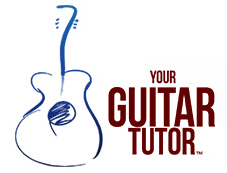There are two families of chords you need to learn to play on the guitar if you wish to be able to play easy guitar songs. The two families of chords adds up to 8 different chords, which you should be able to master with a little persistence and regular short practice sessions. If you want to fast-track your learning, then check out my ebook.
You will need to learn the C family chords, and the G family chords.
With these two sets of chords you can use a small device known as a capo, to play the same shapes you have learnt here, and move them up the neck with the capo. This allows you to play along to a lifetime of songs with as little as 8 chords! All you have to do is learn both families of chords and be able to switch from chord to chord.
The C Family Chords
In my beginner method I get guitar players having fun quickly by using a capo and learning just a handful of chords, before learning how to move between them.
The first family of chords I teach is the C family chords, because this is easier than the equally important G family, and you can begin making progress quickly and start learning a song.
The C Family chords are as follows:
C D minor E minor F G A minor
With this small set of chords you will be amazed how many songs you could learn.
Below are chord diagrams for the C family of chords, taken from the Complete Beginner Guitarists ebook available at http://www.yourguitartutor.co.uk/shop/complete-beginner-guitarist. In Complete Beginner Guitarist you learn all about the notes on the fretboard, how to strum along to songs, how to hold your plectrum, buying your first guitar, tuning your guitar, how to progress into the intermediate and advanced guitar levels, plus much more. You will also understand what the strings are called and the various parts of the guitar.
At this stage I want you to ignore the labelling of the notes on the fretboard diagrams shown further down, and instead focus on getting the right finger on the right fret and string (as the description and picture below chord diagram outlines).
Here is a picture of my hand with the names of each finger and thumb labeled so that you can refer to this when learning the chords
C Major Chord
So to play a C chord you need to place your third finger on the A string 3rd fret, second finger on the D string 2nd fret and first finger on the B string 1st fret. You will also notice the diagram shows dots on the G and high E strings and this means those strings are played open (do not press the string down, instead let it ring out without fretting a note).
You should aim for your fingers to be on their tips, so you do not stop the string above or below from vibrating freely. If you long nail you may find this hinders you from pressing your finger down on the tips.
Notice my thumb is coming around the top and gently resting against the low E string to mute it out.
D Minor Chord
To play your final open minor chord, place your second finger on the 2nd fret G string, third finger on the 3rd fret B string, and your first finger on the 1st fret high E string.
Ensure your D string is ringing as an open string and both the low E and A string are not played, or are muted with your thumb.
E Minor Chord
This chord is easier than the rest of your open minor chords as you simply need to place your first finger on the 2nd fret A string, and your second finger on the 2nd fret D string. All of the other strings need to ring out freely to play this chord properly.
F Major Chord
To play the F chord you need to first place your third finger on the 3rd fret A string, then fourth finger on the 3rd fret D string, followed by second finger 2nd fret G string and finally first finger 1st fret B string. Your first finger can be lazy for this chord because the high E string should be muted by the underside of the first finger. You also need to bring your thumb over the top of the neck to mute the low E string as the low E note does not sound good with the F chord.
G Major Chord
To play the G chord put your second finger on the 3rd fret low E string, first finger 2nd fret A string, third finger 3rd fret B string and finally fourth finger 3rd fret high E string.
Make sure your D and G strings can ring out freely without any accidental muting from your surrounding fingers.
A Minor Chord
Place your second finger on the 2nd fret D string, third finger on the 2nd fret G string and your first finger on the 1st fret B string. Play your A string as an open string as well as your high E string.
So far you have learnt 6 out of the 8 essential chords to learn to be able to play as many easy guitar songs as you wish. There are two more shapes left for you to learn to get this basic grounding in beginner guitar.
You can learn the remaining two shapes and everything you need to know about notes, string names, tuning, strumming and technique in my beginner guitar ebook- ‘Complete Beginner Guitarist‘. You may also be interested in learning my Top 5 Easy Guitar Songs of 2013 once you have learnt the remaining chords.














lessons are great and would like to learn more